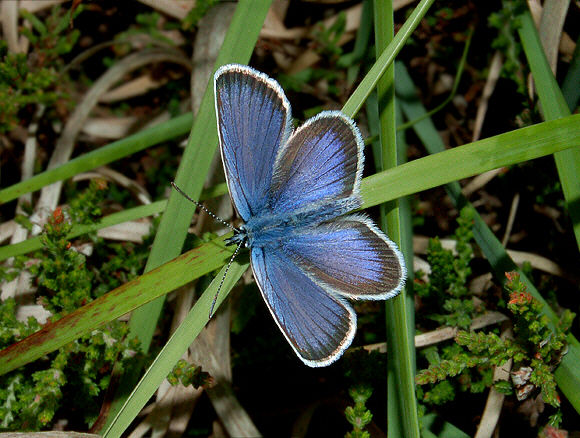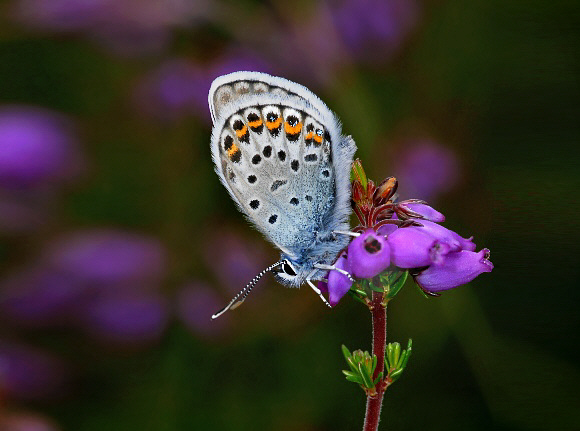 Silver-studded Blue Plebejus argus, male, Ocknell, New Forest, Hampshire – Adrian Hoskins
Silver-studded Blue Plebejus argus, male, Ocknell, New Forest, Hampshire – Adrian Hoskins
Introduction
The Silver-studded Blue gets its English name from the row of silvery-blue submarginal “studs” on the underside hindwings. These vary in size between individuals and from site to site, and in some specimens can be entirely absent. The butterfly was once known as the Lead Argus – a reference to the dull steely blue colour of the male’s forewings, which are quite unlike the more vivid hues of Common Blues and Adonis Blues.
The butterfly is widely distributed across Europe but is absent from central Spain, southern Portugal, Scotland, Ireland and northern Sweden. Beyond Europe its range extends across temperate Asia to northern China and Japan.
The isolated population at Great Ormes Head, an island off the north coast of Wales, differs in many ways from the typical form, and were once considered to be a distinct subspecies caernensis. The butterflies are noticeably smaller than the normal form, females have extensive blue scaling, and the adults emerge in late May – about 3 weeks earlier than other populations.
In Britain argus can’t be confused with any other species, but elsewhere within its range it can easily be mistaken for the near identical Idas Blue Plebejus idas. The two species can only reliably be told apart by examining the tibia on the foreleg of the male – in argus this is spined, in idas it is not.
Other closely related and very similar species occurring in Europe include Reverdin’s Blue Plebejus argyrognomon, and the Zephyr Blue P. pylaon.
 Silver-studded Blue Plebejus argus, male, Prees Heath, Shropshire – Adrian Hoskins
Silver-studded Blue Plebejus argus, male, Prees Heath, Shropshire – Adrian Hoskins
Habitats
Unlike other British blues, this is primarily a heathland butterfly. Although some populations can be enormous, comprising of hundreds or even thousands of butterflies, this is a very localised species, which rarely flies more than a few metres from its emergence site. It breeds on heaths that are damp but not boggy, primarily in Hampshire, Dorset and Surrey; strongly favouring sheltered areas that have regenerated following burning, clearing, or heavy cattle grazing.
Colonies also exist on coastal dunes in Cornwall, south Devon and the Gower peninsula of south Wales. Populations which once existed on chalk grasslands have all become extinct, but there are still large populations on limestone cliffs at Great Ormes Head (an island off the coast of north Wales ), and in the nearby Dulas valley where it was artificially introduced. Small populations also occur in limestone quarries at Portland, Dorset.
Lifecycle
In warmer parts of Europe the butterfly is double brooded, emerging in May and August, but in Britain there is only a single generation, which emerges in late June.
At most heathland sites the eggs are laid singly in July at the base of young shoots of cross-leaved heath Erica tetralix, heather Calluna vulgaris, bell heather Erica cinerea or gorse Ulex europaeus. On the Suffolk Brecklands however eggs are often laid on the underside of bracken fronds – these possess nectaries whose sole function seems to be to attract ants. Although unproven, it is possible that the butterflies have evolved this egg-laying strategy so that the eggs gain protection from being eaten or attacked by parasitoids, by virtue of the presence of the ants.
On limestone sites the eggs are laid on the stems of bird’s foot trefoil Lotus corniculatus or rockrose Helianthemum chamaecistus, very close to the base of the plants. The eggs are always laid close to nests of the ant Lasius niger. The tiny larva develops within the egg in the late summer but doesn’t hatch until the following March. It feeds by day on the flowers and tender leaf tips of the foodplants. The larva is constantly attended by the ants which milk it to obtain a sugary substance exuded from an eversible gland on its back. In return the larva gains protection because the presence of ants deters predatory wasps, spiders and carnivorous bugs.
When ready to pupate, the larva is driven or carried into the ant’s nests. The pupa is attended by the ants until the butterfly is ready to emerge in late June or early July, at which time it crawls out of the nest and makes it’s way up a stem where it settles to expand and dry it’s wings.The butterfly / ant relationship is not a true example of symbiosis – it has been demonstrated that captive larvae which are prevented from having contact with ants invariably die; but the ants are perfectly capable of surviving without the butterfly.
Adult behaviour
The steely blue males are easily seen, as they flutter incessantly over heather or grasses in search of females, stopping occasionally to nectar at bell heather, bird’s foot trefoil or rockrose. Females are much harder to find, as they are far more sedentary and duller in colour, being earthy brown with an indistinct series of orange sub-marginal lunules.

Plebejus argus, male at roost on cross-leaved heath, Prees Heath, Shropshire – Adrian Hoskins
When the sexes meet, copulation takes place almost immediately, with no observable pre-nuptial ritual. Mated pairs can sometimes be found basking with wings in the characteristic three-quarters open position. They remain in cop for about an hour.
Overnight or in overcast weather conditions the butterflies roost on cross-leaved heath, heather, or less commonly amongst grasses or on bushes; adopting the typical head-downward posture shown in the above photograph.
On sunny days the butterflies are active until sunset, and at certain sites can sometimes be found basking in groups of 30 or 40, congregating on bushes or heather clumps to soak up the last remnants of sunlight before going to roost or the night. In the morning these same groups bask communally for about half an hour prior to taking flight.
